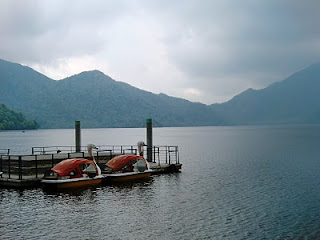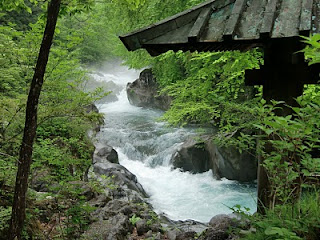 There's my bullet train ride shown on the board - Nozomi 222 bound for Tokyo at 10:02 am. Being a fan of rail travel (as opposed to air and bus travel), I was psyched to experience one of the world's fastest bullet trains, the Shinkansen, and was waiting on the platform a Kyoto station for the 2.5 hour "rapid express" ride.
There's my bullet train ride shown on the board - Nozomi 222 bound for Tokyo at 10:02 am. Being a fan of rail travel (as opposed to air and bus travel), I was psyched to experience one of the world's fastest bullet trains, the Shinkansen, and was waiting on the platform a Kyoto station for the 2.5 hour "rapid express" ride.I hadn't really known about the distinctions between the different classes. But when buying my ticket, the counter lady gave a brief explanation, and I figured that logically the less stops, the better.
Thus I chose the Nozomi, which as you can see, makes fewer stops along the Kyoto to Tokyo route than its Hikari "express" counterpart. The time savings probably aren't all that great, perhaps half an hour, since the Shinkansen does speed through the countryside at a top rate of 300 kilometers per hour.
 Regardless of the class - rapid express or express (I love how the local trains are called "semi-express"), in truth, I was just happy to be in a country with a great rail travel system like Japan,
Regardless of the class - rapid express or express (I love how the local trains are called "semi-express"), in truth, I was just happy to be in a country with a great rail travel system like Japan,given the paucity of good rail travel options in the USA.
In fact, one of my fondest memories of my trips in Switzerland was taking the intercity trains between the different cities, always amazed by their punctuality and efficiency. (Which probably explains why I wear a Swiss Railways watch to this day).
Other than the Amtrak Acela Express service on the Northeast corridor between Boston and Washington DC, travelling by train seems to have gone out of style at home, with no foreseeable revival given the massive costs of upgrading the infrastructure.
Even the much-touted Acela Express reaches top speeds of only 150 mph (210 km/hr), and only on certain sections of the route. Something to do with the tracks, I believe.
 So, there I was eagerly waiting for "my" Nozomi train to arrive, and to while away the time, I watched other Shinkansen trains zoom past the Kyoto station platform.
So, there I was eagerly waiting for "my" Nozomi train to arrive, and to while away the time, I watched other Shinkansen trains zoom past the Kyoto station platform.You could easily tell they were coming - the train would appear in the distance - still seemingly far - but this can be quite deceiving. You only have a few precious seconds to set the perfect angle on your camera's view finder, and remember to brace yourself for the strong gust of cool air that the Shinkansen brings with it to avoid being knocked over.
In a few seconds, the show is all over and you're left to replay the video you've shot, shake your head in disappointment, and then stake out your position on the platform's edge waiting for the next one. Repeat as many times as necessary.
Here is the link to video of the Shinkansen speeding through Kyoto station (if the embedded video below doesn't appear).
 Finally, the Nozomi train came and I took my designated seat inside the designated car. The Shinkansen was very comfortable and had ample legroom.
Finally, the Nozomi train came and I took my designated seat inside the designated car. The Shinkansen was very comfortable and had ample legroom.For people like me who are normally stuck in the middle seat in economy class, this was quite a relief. The smoothness of the ride struck me. In fact, you'd only notice you are traveling at such high speeds when you look out the window at the countryside and everything whizzes by in an instant.
Overall, the Shinkansen is a great way to experience the outstanding Japan rail system (those Swiss better watch out), although it comes at a steep price. My one-way trip between Kyoto and Tokyo came to around 13,520 yen or roughly US$150. (No one said traveling in style would be cheap, I rationalized). A JR pass can be used on the Hikari trains, but not the "rapid express" Nozomi.
Check out this Lonely Planet article to learn more about Japan's amazing bullet trains.
For more of my Japan trip blog posts, click here.








































